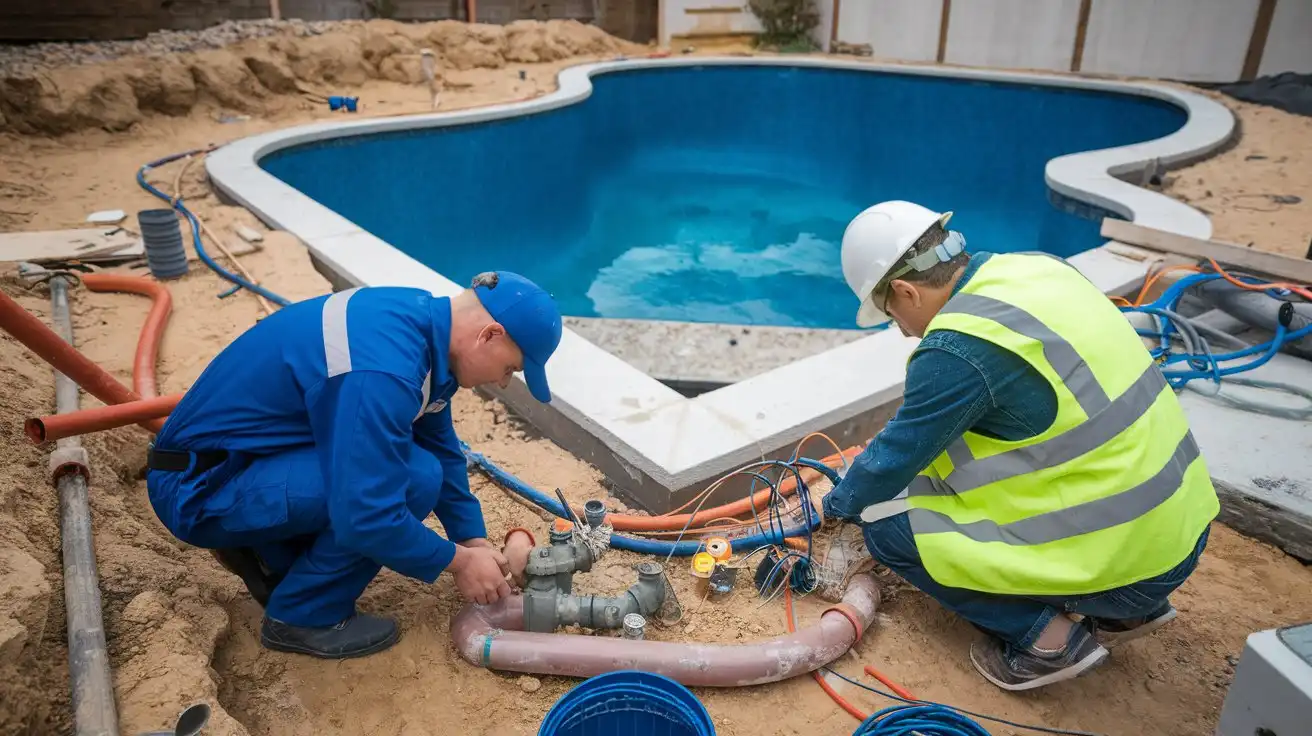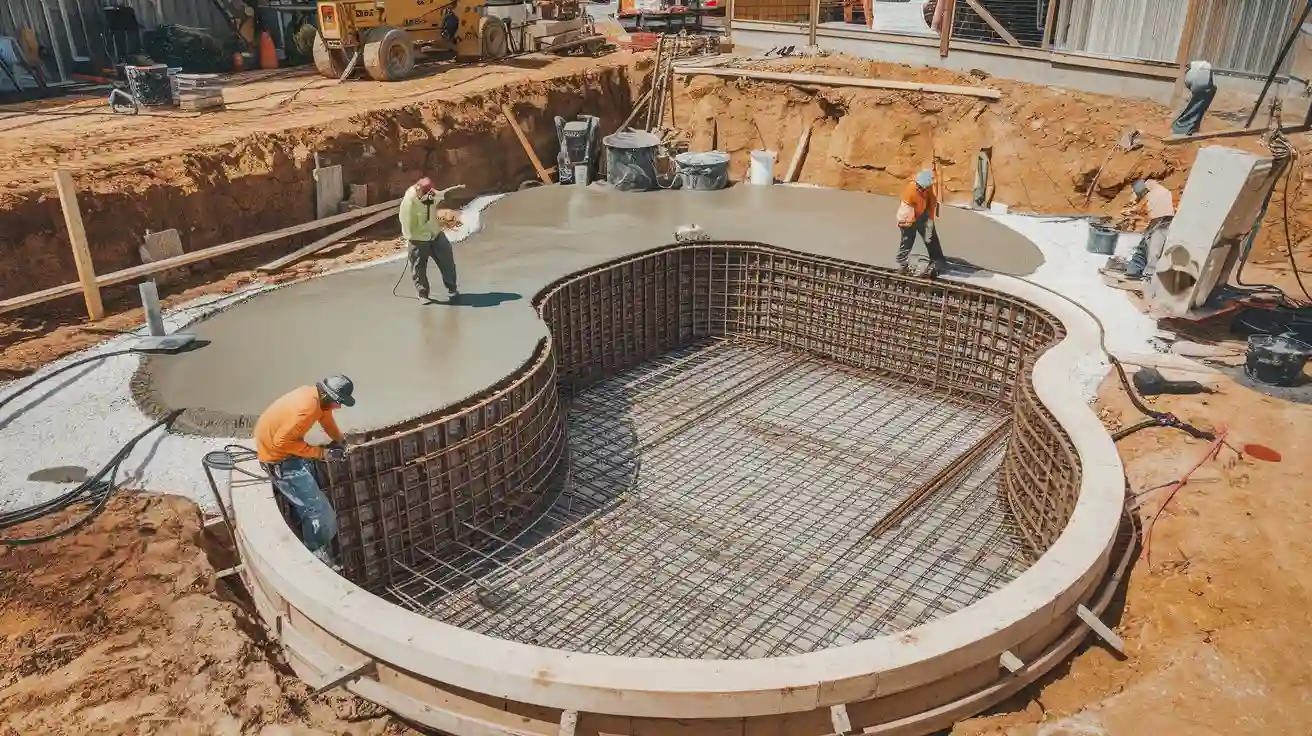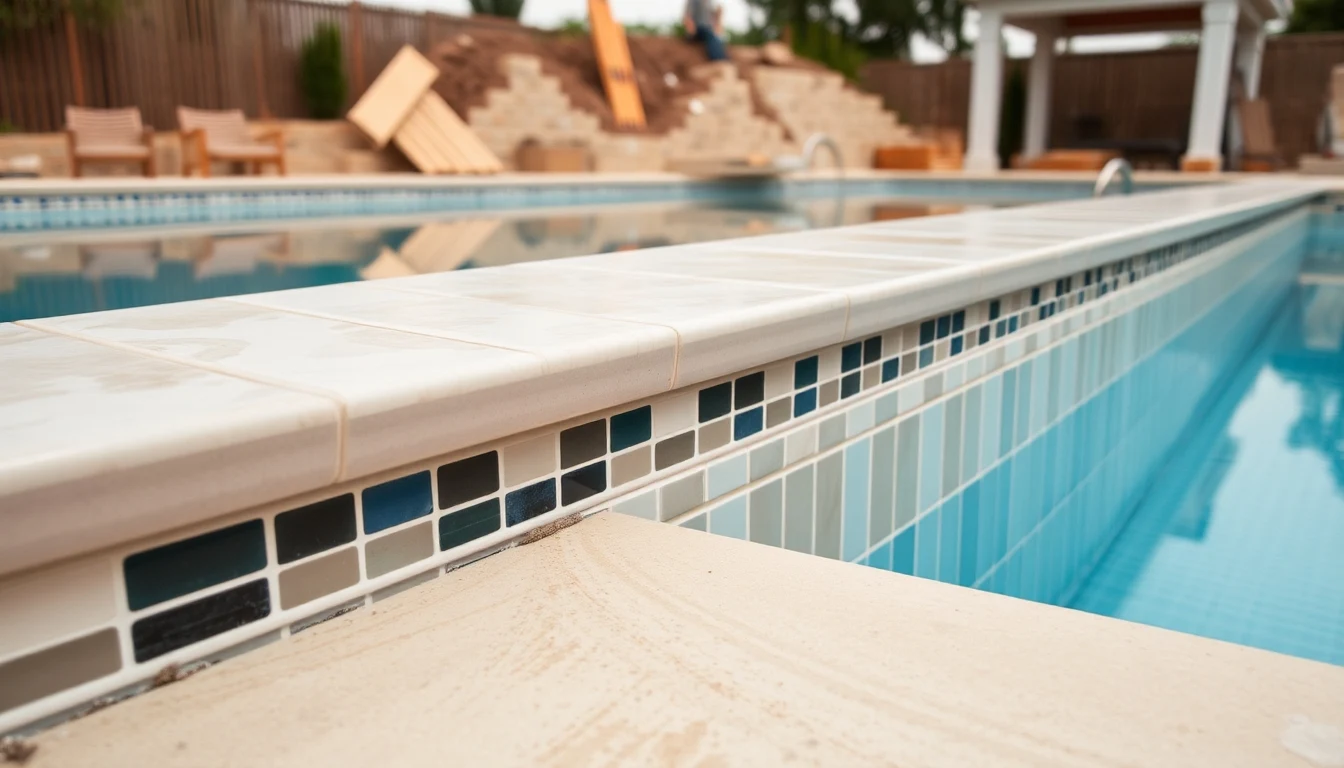Building of swimming pool is a thrilling project that can elevate your outdoor living space into a luxurious retreat. However, transforming the vision of a stunning pool into reality requires careful planning, execution, and attention to detail. This comprehensive guide will walk you through every step of the process, ensuring your dream pool comes to life seamlessly.
1. Planning and Initial Considerations

Before breaking ground, the planning phase is crucial. It sets the foundation for the entire project and ensures that your swimming pool meets your desires, budget, and needs.
A. Purpose and Design
The first step is defining the purpose of your swimming pool. Is it for recreational purposes, fitness, or relaxation? Once you determine its primary use, design options will fall into place. Pools come in various shapes, sizes, and types, including:
- Infinity pools: Ideal for modern homes and a sleek, luxurious look.
- Lap pools: Perfect for fitness enthusiasts who value functionality over aesthetics.
- Natural pools: These blend with the environment and offer a more eco-friendly option.
- Plunge pools: Great for smaller spaces where relaxation is the priority.
The design will also be influenced by your backyard layout, landscaping, and architectural style of the house.
B. Budgeting
Setting a budget is vital as the cost of building a swimming pool can vary significantly based on materials, size, and additional features like lighting or waterfalls. An average pool build can range from $30,000 to $100,000 or more, depending on these factors. To avoid unexpected costs, get multiple quotes from contractors and ensure that everything from permits to labor is covered.
C. Site Evaluation
A site evaluation by a professional ensures that your property is suitable for a swimming pool. They will examine factors like soil stability, slope, drainage, and proximity to utilities. This stage helps identify potential challenges like rocky terrain or water tables, which might require specialized construction techniques.
D. Choosing a Contractor
Researching and selecting the right contractor is one of the most important decisions in the pool-building process. Look for companies with strong reputations, relevant experience, and positive customer reviews. Licensed and insured contractors should provide detailed contracts covering the scope of work, timelines, and payment schedules.
2. Permits and Regulations

Building a swimming pool requires following local building codes and obtaining necessary permits. Failure to do so can result in fines or project delays.
A. Building Permits
Most local governments require permits to build a swimming pool. These permits ensure that the pool complies with safety and environmental regulations, such as proper fencing and drainage systems. It’s the contractor’s responsibility to apply for these permits, but it’s a good idea for the homeowner to stay informed about local requirements.
B. Zoning and Property Lines
Zoning laws dictate where a pool can be placed on your property. In some areas, pools must be a certain distance from property lines, fences, or structures. Check with your local zoning office to understand these limitations and prevent future disputes with neighbors.
C. Environmental and Safety Regulations
Many areas have strict guidelines on water usage, drainage, and chemical storage to prevent environmental damage. Furthermore, safety regulations like pool covers, alarms, and secure fencing are often mandated to prevent accidents, especially if children are present.
3. Excavation and Pool Layout
Once the planning is complete, the physical construction begins with excavation and setting the pool layout.
A. Marking the Pool Location
Before excavation, the pool’s exact layout is marked on the ground. This outline gives a clear visual of where the pool will be and helps ensure that everything is aligned correctly. Make sure to confirm the positioning to avoid complications later.
B. Excavation
Excavation is one of the most critical steps in the pool-building process. Large machinery is used to dig the hole for the pool. Depending on the pool’s size, shape, and the soil’s condition, this process can take anywhere from a few days to a week. This step also involves removing any large rocks or debris that could interfere with the pool’s foundation.
C. Forming the Pool Structure
Once the hole is dug, the pool structure begins to take shape. A steel rebar framework is placed in the hole to reinforce the pool’s structure. This creates the skeleton of the pool, ensuring strength and durability.
4. Plumbing and Electrical Work

With the pool structure in place, the next step involves installing the necessary plumbing and electrical systems.
A. Pool Plumbing
Proper plumbing is essential for pool maintenance and function. The plumbing system will include pipes for water circulation, filtration, heating, and drainage. Professional plumbers will ensure that the system is installed correctly and designed to prevent leaks, ensuring efficient water movement throughout the pool.
B. Electrical Work
In addition to plumbing, electrical systems are also installed during this phase. This includes wiring for lighting, heating, and the pool pump. Ensure that a licensed electrician handles this task to comply with safety codes and regulations. Adding energy-efficient pool equipment, like LED lights or solar heaters, can reduce long-term energy costs.
5. Pool Shell Construction

The next major step in the process is constructing the pool shell. Depending on the material you choose, this phase may vary slightly in procedure.
A. Gunite or Shotcrete Pools
If you choose a concrete pool, either gunite or shotcrete is sprayed over the steel framework. These materials are durable and customizable, allowing you to shape the pool according to your design. After spraying the concrete, the shell needs to be cured for several weeks to ensure stability.
B. Fiberglass Pools
Fiberglass pools arrive pre-formed and are lowered into the excavation site. This process is much faster than constructing a concrete shell and can be completed in a few days. Fiberglass pools are low-maintenance and smooth to the touch, making them a popular choice for homeowners.
C. Vinyl Pools
For vinyl pools, the structure is lined with a vinyl sheet that fits the pool’s shape. These pools are cost-effective and offer a range of design possibilities, though they may require more maintenance than concrete or fiberglass options.
6. Tiling and Coping

Once the shell is complete, the next step is tiling and coping, which adds both aesthetic appeal and functionality to your pool.
A. Tiling
Tiles are installed around the waterline of the pool to enhance its appearance and ensure easy cleaning. Choose tiles that complement your pool’s design and blend well with the overall landscaping. Tiles come in various styles, including ceramic, glass, and stone, allowing for creative customization.
B. Coping
Coping refers to the material used to cap the pool’s edge. It helps protect the pool’s shell and provides a smooth, safe transition between the pool and the surrounding deck. Common coping materials include concrete, brick, and natural stone, and they can be selected to match your home’s exterior or the surrounding environment.
7. Decking and Landscaping
A pool’s surrounding area is just as important as the pool itself, as it sets the tone for relaxation and entertainment.
A. Decking
The pool deck provides a functional space for lounging, dining, and sunbathing. Decking materials vary in cost, durability, and style. Common options include:
- Concrete: Durable and easy to maintain, concrete can be stamped or stained for a custom look.
- Pavers: Provide a natural stone appearance and are resistant to cracking.
- Wood: A warm, natural option that requires regular maintenance but offers great visual appeal.
B. Landscaping
Landscaping plays a significant role in creating the perfect pool environment. Incorporating greenery, trees, and water features can enhance the tranquility and beauty of your outdoor space. Consider adding privacy elements such as tall plants or fencing to create a serene oasis.
8. Pool Equipment and Features Installation

Once the structure and aesthetics are in place, it’s time to install the functional components that keep your pool running smoothly.
A. Pool Filter and Pump
The pool filter and pump system work together to keep the water clean and circulate it properly. The size of the pump and filter will depend on the pool’s size and usage frequency. Invest in energy-efficient equipment to reduce operational costs.
B. Heating Systems
Heating systems, such as gas heaters or solar-powered units, extend the swimming season by keeping the water at a comfortable temperature year-round. Make sure the system is compatible with your pool size and location.
C. Additional Features
Many homeowners add optional features to enhance their pool experience. Some popular additions include:
- Waterfalls and fountains: For a luxurious and tranquil atmosphere.
- Lighting systems: LED lights or fiber optics can create stunning nighttime effects.
- Automated covers: Help maintain the pool’s temperature and reduce cleaning efforts.
- Spa or hot tub: Adding a spa can elevate your pool’s versatility and relaxation potential.
9. Final Inspections and Pool Filling
Before you can dive into your new pool, it must pass final inspections to ensure everything is safe and up to code.
A. Inspections
Your contractor will schedule inspections to confirm that the plumbing, electrical, and structural elements meet local building codes. Passing these inspections is crucial for safety and long-term pool functionality.
B. Pool Filling
After approval, it’s time to fill your pool with water. This may take several hours or even days, depending on the pool’s size. Once filled, your pool technician will balance the water’s chemical levels to ensure it’s safe for swimming.
10. Pool Maintenance and Care

After the build is complete, regular maintenance is essential to keep your pool in top condition.
A. Regular Cleaning
Use a pool skimmer, vacuum, and brush to clean the water’s surface, walls, and floor. This helps prevent algae buildup and ensures that your pool remains crystal clear.
B. Chemical Balancing
Properly balanced chemicals are vital for water safety and clarity. Regularly check the chlorine, pH, and alkalinity levels to avoid issues like cloudy water or skin irritation.
C. Equipment Upkeep
Regularly inspect your pool’s pump, filter, and heater to ensure they are functioning efficiently. Routine servicing by a professional can prevent costly repairs down the line.
Conclusion
Building a swimming pool is an exciting journey that can transform your backyard into a personal paradise. By following these steps, from planning and design to final maintenance, you can ensure a smooth process and long-lasting enjoyment. With the right planning, contractor, and features, you’ll soon be swimming in the pool of your dreams. More step-by-step information on building a pool..>>

